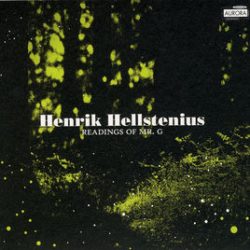Henrik Hellstenius’ music is lively and animated, with an interaction between musical elements that has a strong dramatic element, a reflection of the fact that Hellstenius has worked a lot with music for theatre and dance. The listener experiences an immediate sense of an underlying melodic, even lyrical, sensitivity, either directly or indirectly present.
In Readings of Mr G, instrumental and theatrical elements are combined. The percussion soloist is not only a musician but speaker also: an actor in the widest sense. In the beautiful violin concerto ‘By the voice a faint light is shed’, Hellstenius creates the illusion of a temporal paradox, in that the music has a forward-moving development, but twists and turns will inevitably return us to the point of origin, revealing what the composer calls a “spiral form”.
READINGS OF MR. G.
In the percussion concerto Readings of Mr.G, instrumental and theatrical elements are combined. The percussionist is not only a musician but also speaker also; an actor in the widest sense. The concerto was written especially for the percussionist Hans-Kristian Kjos Sørensen and the Norwegian Chamber Orchestra. The spoken texts are taken from the world of ideas of the mystic Georges Ivanovitch Gurdjieff as written down by his student Peter Ospensky. Reading in the work does not just refer to reciting the text out loud; rather it is a form of an artistic project, a rereading; i.e musical interpretation and reflection on the original text. There is a similar, parallel musical “reading” of excerpts from “Vortex Temporum”, one of the last works of the French composer Gérard Grisey (1946-1998). Hellstenius carries Grisey´s composition further in the form of musical superimpositions, and by expounding details and adding his own commentary. The “Mr.G” of the title is thus a double character, present at various levels in the work. These “readings” are in accordance with what has been one of the principal traditions of composition for as long as the craft has existed. New works do not arise from a vacuum or as new “pure” ideas drawn from abstract creativity; they are created through active reaction to existing raw material, incorporated into the work in the form of text or sound, as in the familiar “cantus firmus” parts of medieval and Renaissance compositions. (Such parts consist of already existing music, not just notes).
At the same time, there is something deeply personal about Hellstenius´ choice of Mr G´s – Hellstenius studied with Grisey from 1993-1996. Grisey was one of the central figures of the French school of “spectral music”; in addition to his love for refined timbres and textures that characterize the music, he was also very concerned with the mutual relationship between stringency and playfulness in the craft of composition in general, and with the various perceptions of time which can be created in the temporal art of music. These perspectives have always been important to Hellstenius. The link to Gurdjieff goes via the composer´s paternal grandmother Lilli Hellstenius, who spent a large part of her life studying with Gurdjieff´s pupil John G. Bennett. Lilli Hellstenius emphasized the necessity of achieving a greater understanding of the world around oneself, and not least of finding the courage to live one´s own life. When the percussionist is forced to sing and speak, he is pushed beyond the limit of being able to rely on routine and self-confidence. The courage this takes and the achievement reached express the vulnerability that is present when one exposes oneself to the challenges of life. This is crucial to the work; with a professional singer, the experience would not have been as apparent. And it expresses not least what Hellstenius call “the unmistakable tinge of comedy in us all”.
Morten Eide Pedersen

